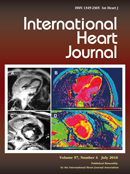57 巻, 4 号
選択された号の論文の25件中1~25を表示しています
- |<
- <
- 1
- >
- >|
Editorials
-
2016 年 57 巻 4 号 p. 391-392
発行日: 2016年
公開日: 2016/07/27
[早期公開] 公開日: 2016/07/11PDF形式でダウンロード (533K) -
2016 年 57 巻 4 号 p. 393-394
発行日: 2016年
公開日: 2016/07/27
[早期公開] 公開日: 2016/07/11PDF形式でダウンロード (451K)
Reviews
-
2016 年 57 巻 4 号 p. 395-399
発行日: 2016年
公開日: 2016/07/27
[早期公開] 公開日: 2016/07/11PDF形式でダウンロード (1008K) -
2016 年 57 巻 4 号 p. 400-407
発行日: 2016年
公開日: 2016/07/27
[早期公開] 公開日: 2016/07/11PDF形式でダウンロード (3847K)
Clinical Studies
-
2016 年 57 巻 4 号 p. 408-416
発行日: 2016年
公開日: 2016/07/27
[早期公開] 公開日: 2016/06/29PDF形式でダウンロード (1017K) -
2016 年 57 巻 4 号 p. 417-423
発行日: 2016年
公開日: 2016/07/27
[早期公開] 公開日: 2016/06/29PDF形式でダウンロード (580K) -
2016 年 57 巻 4 号 p. 424-429
発行日: 2016年
公開日: 2016/07/27
[早期公開] 公開日: 2016/07/07PDF形式でダウンロード (1159K) -
2016 年 57 巻 4 号 p. 430-433
発行日: 2016年
公開日: 2016/07/27
[早期公開] 公開日: 2016/06/29PDF形式でダウンロード (481K) -
2016 年 57 巻 4 号 p. 434-440
発行日: 2016年
公開日: 2016/07/27
[早期公開] 公開日: 2016/07/11PDF形式でダウンロード (667K) -
2016 年 57 巻 4 号 p. 441-448
発行日: 2016年
公開日: 2016/07/27
[早期公開] 公開日: 2016/07/11PDF形式でダウンロード (837K) -
2016 年 57 巻 4 号 p. 449-455
発行日: 2016年
公開日: 2016/07/27
[早期公開] 公開日: 2016/07/07PDF形式でダウンロード (1119K) -
2016 年 57 巻 4 号 p. 456-460
発行日: 2016年
公開日: 2016/07/27
[早期公開] 公開日: 2016/07/07PDF形式でダウンロード (933K) -
2016 年 57 巻 4 号 p. 461-465
発行日: 2016年
公開日: 2016/07/27
[早期公開] 公開日: 2016/06/29PDF形式でダウンロード (918K) -
2016 年 57 巻 4 号 p. 466-472
発行日: 2016年
公開日: 2016/07/27
[早期公開] 公開日: 2016/07/07PDF形式でダウンロード (1365K) -
2016 年 57 巻 4 号 p. 473-476
発行日: 2016年
公開日: 2016/07/27
[早期公開] 公開日: 2016/07/11PDF形式でダウンロード (661K)
Experimental Studies
-
2016 年 57 巻 4 号 p. 477-482
発行日: 2016年
公開日: 2016/07/27
[早期公開] 公開日: 2016/06/29PDF形式でダウンロード (636K) -
2016 年 57 巻 4 号 p. 483-489
発行日: 2016年
公開日: 2016/07/27
[早期公開] 公開日: 2016/06/29PDF形式でダウンロード (1485K) -
2016 年 57 巻 4 号 p. 490-495
発行日: 2016年
公開日: 2016/07/27
[早期公開] 公開日: 2016/07/11PDF形式でダウンロード (1144K) -
2016 年 57 巻 4 号 p. 496-502
発行日: 2016年
公開日: 2016/07/27
[早期公開] 公開日: 2016/07/11PDF形式でダウンロード (758K)
Case Reports
-
2016 年 57 巻 4 号 p. 503-506
発行日: 2016年
公開日: 2016/07/27
[早期公開] 公開日: 2016/06/29PDF形式でダウンロード (1679K) -
2016 年 57 巻 4 号 p. 507-510
発行日: 2016年
公開日: 2016/07/27
[早期公開] 公開日: 2016/07/07PDF形式でダウンロード (2405K) -
2016 年 57 巻 4 号 p. 511-514
発行日: 2016年
公開日: 2016/07/27
[早期公開] 公開日: 2016/07/07PDF形式でダウンロード (939K) -
2016 年 57 巻 4 号 p. 515-518
発行日: 2016年
公開日: 2016/07/27
[早期公開] 公開日: 2016/07/07PDF形式でダウンロード (1536K) -
2016 年 57 巻 4 号 p. 519-521
発行日: 2016年
公開日: 2016/07/27
[早期公開] 公開日: 2016/06/29PDF形式でダウンロード (781K) -
2016 年 57 巻 4 号 p. 522-524
発行日: 2016年
公開日: 2016/07/27
[早期公開] 公開日: 2016/07/07PDF形式でダウンロード (430K)
- |<
- <
- 1
- >
- >|
